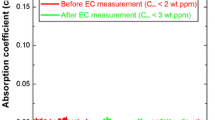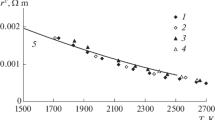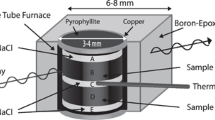Abstract
The electrical conductivity of pyroxene andesite was in situ measured under conditions of 1.0–2.0 GPa and 673–1073 K using a YJ-3000t multi-anvil press and Solartron-1260 Impedance/Gain-phase analyzer. Experimental results indicate that the electrical conductivities of pyroxene andesite increase with increasing temperature, and the electrical conductivities decrease with the rise of pressure, and the relationship between electrical conductivity (σ) and temperature (T) conforms to an Arrhenius relation within a given pressure and temperature range. When temperature rises up to 873–923 K, the electrical conductivities of pyroxene andesite abruptly increase, and the activation enthalpy increases at this range, which demonstrates that pyroxene andesite starts to dehydrate. By the virtue of the activation enthalpy (0.35–0.42 eV) and the activation volume (−6.75 ± 1.67 cm3/mole) which characterizes the electrical properties of sample after dehydration, we consider that the conduction mechanism is the small polaron conduction before and after dehydration, and that the rise of carrier concentration is the most important reason of increased electrical conductivity.









Similar content being viewed by others
References
Addison, W. & E., Sharp, J. H. (1962). 716. Amphiboles. Part III. The reduction of crocidolite. Journal of the Chemical Society (Resumed), 3693–3698.
Christensen, N. I., & Mooney, W. D. (1995). Seismic velocity structure and composition of the continental crust: a global view. Journal of Geophysical Research, 100(B6), 9761–9788.
Clowe, C. A., Popp, R. K., & Fritz, S. J. (1988). Exprimental investigation of the effect of oxygen fugacity on ferric-ferrous ratios and unit-cell parameters of four natural clinoamphiboles. American Mineralogist, 73, 487–499.
Dai, L. D., Hu, H. Y., Li, H. P., et al. (2014). Influence of temperature, pressure, and chemical composition on the electrical conductivity of granite. American Mineralogist, 99(7), 1420–1428.
Dai, L. D., Hu, H. Y., Li, H. P., et al. (2016). Influence of temperature, pressure, and oxygen fugacity on the electrical conductivity of dry eclogite, and geophysical implications. Geochemistry, Geophysics, Geosystems, 17, 2394–2407.
Dai, L. D., Jiang, J. J., Li, H. P., et al. (2015). Electrical conductivity of hydrous natural basalts at high temperatures and pressures. Journal of Applied Geophysics, 112, 290–297.
Dai, L. D., & Karato, S. (2009). Electrical conductivity of wadsleyite at high temperatures and high pressures. Earth and Planetary Science Letters, 287, 277–283.
Dai, L. D., & Karato, S. (2014a). High and highly anisotropic electrical conductivity of the asthenosphere due to hydrogen diffusion in olivine. Earth and Planetary Science Letters, 408, 79–86.
Dai, L. D., & Karato, S. (2014b). Influence of FeO and H on the electrical conductivity of olivine. Physics of the Earth and Planetary Interiors, 237, 73–79.
Dai, L. D., Li, H. P., Hu, H. Y., et al. (2012). The effect of chemical composition and oxygen fugacity on the electrical conductivity of dry and hydrous garnet at high temperatures and pressures. Contributions to Mineralogy and Petrology, 163(4), 689–700.
Dai, L. D., Li, H. P., Hu, H. Y., et al. (2013). Electrical conductivity of Alm82Py15Grs3 almandine-rich garnet determined by impedance spectroscopy at high temperatures and high pressures. Tectonophysics, 608, 1086–1093.
Ernst, W. G., & Wai, C. M. (1970). Mössbauer, infrared X-ray and optical study of cation ordering and dehydrogenation in natural and heat treated sodic amphiboles. American Mineralogist, 55, 1226–1258.
Ferri, F., Gibert, B., Violay, et al. (2013). Electrical conductivity in a partially molten crust from measurements on metasedimentary enclaves. Tectonophysics, 586, 84–94.
Hirsch, L. M., Shankland, T. J., & Duba, A. G. (1993). Electrical conduction and polaron mobility in Fe-bearing olivine. Geophysical Journal International, 114(1), 36–44.
Hu, H. Y., Dai, L. D., Li, H. P., et al. (2015). Temperature and pressure dependence of electrical conductivity in synthetic anorthite. Solid State Ionics, 276, 136–141.
Huang, X. G., Bai, W. M., Xu, Y. S., et al. (2005a). Influence of hydrogen on electrical conductivity of wadsleyite and ringwoodite with its geodynamics implications. Acta Petrological Sinica., 21(6), 1743–1748. (in Chinese with English abstract).
Huang, X. G., Huang, X. G., & Bai, W. M. (2012). Study on the electrical conductivity of carbonated peridotite. Chinese Journal of Geophysics, 55(9), 3144–3151. (in Chinese with English abstract).
Huang, X. G., Xu, Y. S., & Karato, S. (2005b). Water content in the transition zone from electrical conductivity of wadsleyite and ringwoodite. Nature, 434, 746–749.
Huebner, J. S., & Dillenburg, R. G. (1995). Impedance spectra of hot, dry silicate minerals and rock-qualitative interpretation of spectra. American Mineralogist, 80(1–2), 46–64.
Hui, K. S., Zhang, H., Li, H. P., et al. (2015). Experimental study on the electrical conductivity of quartz andesite at high temperature and high pressure: evidence of grain boundary transport. Solid Earth, 6, 1037–1043.
Katsura, T., Yokoshi, S., Kawabe, K., et al. (2007). Pressure dependence of electrical conductivity of (Mg, Fe)SiO3 ilmenite. Physical Chemical Minerals, 34(4), 249–355.
Laumonier, M., Gaillard, F., & Sifre, D. (2015). The effect of pressure and water concentration on the electrical conductivity of dacitic melts: implication for magnetotelluric imaging in subduction areas. Chemical Geology, 418, 66–76.
Li, H. P., Xie, H. S., Guo, J., et al. (1998). In situ control oxygen fugacity at high temperature and high pressure: a Ni-O system. Geophysical Research Letters, 25(6), 817–820.
Li, H. P., Xie, H. S., Guo, J., et al. (1999). In situ control oxygen fugacity at high temperature and high pressure. Journal of Geophysical Research, 104(B12), 29439–29451.
Nover, G. (2005). Electrical properties of crustal and mantle rocks—a review of laboratory measurements and their explanation. Surveys In Geophysics, 26, 593–651.
Nover, G., Will, G., & Waitz, R. (1992). Pressure-induced phase-transition in Mg2GeO4 as determined by frequency-dependent complex electrical-resistivity measurements. Physics and Chemistry of Minerals, 19(3), 133–139.
Popp, K. R., & Bryndzia, L. T. (1992). Statistical anaysis of Fe3+, Ti, and OH in kaersutite from alkalic igneous rocks and mafic mantle xenoliths. American Mineralogist, 77, 1250–1257.
Popp, K. R., Hibbert, H. A., & Lamb, W. M. (2006). Oxy-amphibole equilibria in Ti-bearing calcic amphiboles: experimental investigation and petrologic implications for mantle-derived amphiboles. American Mineralogist, 91(1), 54–66.
Roberts, J. J., & Tyburczy, J. A. (1991). Frequency dependent electrical properties of polycrystalline olivine compacts. Journal of Geophysical Research, 96(B10), 16205–16222.
Romano, C., Poe, B. T., Kreidie, N., et al. (2006). Electrical conductivities of pyrope-almandine garnets up to 19 GPa and 1700 °C. American Mineralogist, 91, 1371–1377.
Scarlato, P., Poe, B. T., & Freda, C. (2004). High-pressure and high-temperature measurements of electrical conductivity in basaltic rocks from Mount Etna, Sicily, Italy. Journal of Geophysical Research, 109(B2), 210–220.
Schmidbauer, E., Kunzmann, T., Fehr, T., et al. (2000). Electrical resistivity and 57Fe mössbauer spectra of Fe-bearing calcic amphiboles. Physics and Chemistry of Minerals, 27(5), 347–356.
Shankland, T. J., Peyronneau, J., & Poirier, J. P. (1993). Electrical conductivity of the earth’s lower mantle. Nature, 366, 453–455.
Shinoda, K., Yamakata, M., Nanba, T., et al. (2002). High-pressure phase transition and behavior of protons in brucite Mg(OH)2: a high-pressure–temperature study using IR synchrotron radiation. Physics and Chemistry of Minerals, 29(6), 396–402.
Song, M. S., Xie, H. S., Zheng, H. F., et al. (1996). Determination of serpentine dehydration temperature at 1–5 GPa by the method of electrical conductivity. Chinese Science Bulletin, 41(21), 1815–1819.
Tolland, H. G. (1973). Mantel conductivity and electrical properties of garnet, mica and amphibole. Nature, 241, 35–36.
Tyburczy, J. A., & Waff, H. S. (1983). Electrical conductivity of molten basalt and andesite to 25 kilobars pressure: geophysical significance and implications for charge transport and melt structure. Journal of Geophysical Research, 88(B3), 2413–2430.
Vanyan, L. L., & Gliko, A. O. (1999). Seismic and electromagnetic evidence of dehydration as a free water source in the reactivated crust. Geophysical Journal International, 137(1), 159–162.
Waff, H. S., & Weill, D. F. (1975). Electrical conductivity of magmatic liquids effects of temperature: effects of temperature, oxygen fugacity and composition. Earth and Planetary Science Letters, 28(2), 254–260.
Wang, D. J., Guo, Y. X., Yu, Y. J., et al. (2012). Electrical conductivity of amphibole-bearing rocks: influence of dehydration. Contributions to Mineralogy and Petrology, 164, 17–25.
Wu, X. P., Zhang, B. H., Xu, Y. S., et al. (2010). Electrical conductivity measurements of periclase under high pressure and high temperature. Physica B, 405(1), 53–56.
Xu, Y. S., McCammon, C., & Poe, B. T. (1998). The effect of alumina on the electrical conductivity of silicate perovskite. Science, 282, 922–924.
Xu, Y. S., Shankland, T. J., & Duba, A. G. (2000). Pressure effect on electrical conductivity of mantle olivine. Physics of the Earth and Planetary Interiors, 118(1–2), 149–161.
Yang, X. Z., Keppler, H., McCammon, C., et al. (2012). Electrical conductivity of orthopyroxene and plagioclase in the lower crust. Contributions to Mineralogy and Petrology, 163(1), 33–48.
Zhu, M. X., Xie, H. S., Guo, J., et al. (1999). Electrical conductivity measurement of serpentine at high temperature and pressure. Chinese Science Bulletin, 44(20), 1903–1907.
Zhu, M. X., Xie, H. S., Guo, J., et al. (2001). Impedance spectroscopy analysis on electrical properties of serpentine at high pressure and high temperature. Science in China (Series D), 44(4), 336–345.
Acknowledgments
This research was financially supported by the Strategic Priority Research Program (B) of the Chinese Academy of Sciences (XDB 18010401), Key Research Projects of the Frontier Science of the Chinese Academy of Sciences (QYZDB-SSW-DQC009), “135” Program of the Institute of Geochemistry of CAS, Hundred Talents Program of CAS, Youth Innovation Promotion Association of CAS, NSF of China (41474078, 41304068 and 41174079) and Open Foundation of Institute of Geology and Geophysics of CAS.
Author information
Authors and Affiliations
Corresponding author
Rights and permissions
About this article
Cite this article
Hui, K., Dai, L., Li, H. et al. Experimental Study on the Electrical Conductivity of Pyroxene Andesite at High Temperature and High Pressure. Pure Appl. Geophys. 174, 1033–1041 (2017). https://doi.org/10.1007/s00024-016-1401-1
Received:
Revised:
Accepted:
Published:
Issue Date:
DOI: https://doi.org/10.1007/s00024-016-1401-1




